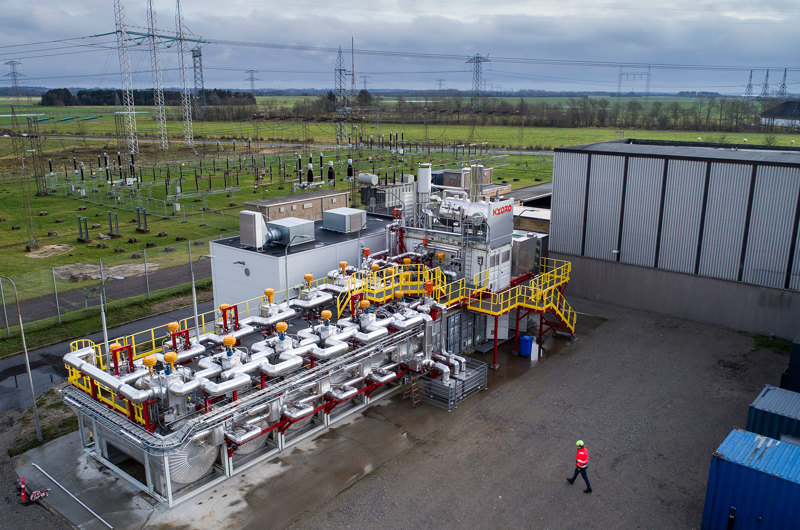The Heatcube facility at Aalborg Forsyning is one of the solutions that can improve storage in the future. The facility in Aalborg can store 18 MWh of heat and is expected to provide up to 5,000 MWh annually, equivalent to the consumption of about 275 single-family homes. Photo: Jesper Voldgaard
The Danish Center for Energy Storage envisions Denmark leading in energy storage, including system integration, to accelerate the green transformation of district heating.
The dominance of green, fluctuating energy sources in the future Danish energy system will require energy storage on a larger scale than before.
Energy storage even has its standard-bearer, the Danish Center for Energy Storage (DaCES), which has been working since 2021 to make Denmark a leader in research, technology development, innovation, application, integration, education, and energy storage.
“We are an independent, neutral, member-funded organization working diligently to make energy storage a Danish strength, much like we have developed strengths in other green technologies in Denmark,” says Niels Dyreborg Nielsen, Technical Chief Consultant at the Danish Center for Energy Storage.
“We need to make storage a Danish strength, and it requires that the energy industry, industrial sector, consultants, suppliers, and researchers work purposefully together to develop future storage solutions.”
Niels Dyreborg Nielsen, Technical Chief Consultant at the Danish Center for Energy Storage.
In the report “Status, Strengths, Synergies – DaCES’ report on energy storage in Denmark 2023,” the center presents 17 recommendations across five areas: thermal energy storage, batteries, PtX, system integration, and education.
“We need to make storage a Danish strength, and it requires that the energy industry, industrial sector, consultants, suppliers, and researchers work purposefully together to develop future storage solutions. Collaboration across disciplines requires breaking down silo thinking. This is a task the center contributes to by bringing all relevant stakeholders together for experience and knowledge sharing in an independent professional forum like DaCES,” says Niels Dyreborg Nielsen.
Flexible and integrated energy storage
The report describes the challenges and solutions the Danish Center for Energy Storage faces.
“Denmark’s extensive district heating network can be seen as one large heat tank, which can improve the cost-effectiveness of heat pumps and electric boilers. These can flexibly produce heat during low electricity prices and simultaneously store heat much more cost-effectively in district heating systems, accumulation tanks, or steam heat storage than in electrical storage.
In addition, the utilization of otherwise wasted heat from industries, where PtX plants and data centers can also eventually deliver significant amounts of heat,” says Niels Dyreborg Nielsen.
He does not want to point to specific solutions as generally the most optimal. Much will depend on local conditions, including synergies between industries, proximity to established district heating networks and facilities, and heat demand, among other factors.
“We do not engage in specific advice. Most technologies have advantages and disadvantages. For a district heating company, much will depend on possible energy partners and heat consumers nearby. Are there suppliers of excess heat? Should one produce all its heat? Can one assist a data center with cooling and, in turn, receive excess heat? Should one provide system services to the electricity grid? All heating plants using electricity for heat production should consider energy storage, which can mitigate fluctuating electricity costs and potentially provide system services,” says Niels Dyreborg Nielsen.
Among the recommendations for thermal storage is increased collaboration with the industry on the need for high-temperature heat (over 100 °C), which can help the industry with decarbonization. Heating plants with heat pumps can advantageously consider both cooling and heating customers, utilizing both sides of this technology—with storage as a crucial support. Additionally, the center recommends abolishing the price ceiling on excess heat so it is used much more and with storage as a vital component to making excess heat projects profitable.
Higher temperatures are on the way.
High-temperature storage—above approximately 100 °C—provides some application possibilities that water-based storage below 100 °C does not offer. New markets and collaboration opportunities for heating plants open up here.
“Some new types of high-temperature storage have various applications, with district heating being one among several.
Storage at high temperatures, such as molten salt at up to 700 °C, enables the generation of high-temperature process steam, which, through steam turbines connected to generators, can convert heat to electricity and thereby contribute to the stabilization of the electricity grid. The industry often burns fossil fuels to achieve high-temperature process steam. Here, molten salt heated with renewable electricity can help the industry decarbonize,” says Niels Dyreborg Nielsen.
Other storage media for high-temperature storage include hot stones, metals, and phase-change materials, which generally require research, development, and demonstration before they are commercially available.
“The technological development of storage media and solutions must show where efficiency and applicability are greatest. Therefore, we in the center are focused on promoting technological development through professional dialogue across disciplines, sectors, and levels,” says Niels Dyreborg Nielsen.
He assesses that Denmark is already a leader in several thermal storage technologies and has well-functioning solutions for storing heat below 100 °C.
“But optimizing the technologies is necessary to deliver heat and cold in an intelligent and flexible interaction with fluctuating renewable energy. The major challenge and the significant untapped potential lie in high-temperature storage, which is crucial for achieving full decarbonization of the industry but can also contribute to greener district heating.
However, optimal system integration and sector coupling will require a targeted research, development, and demonstration effort, which is highly demanded and so far underprioritized among decision-makers and funders,” says Niels Dyreborg Nielsen.
This article has been published as part of a theme on storage in the magazine Fjernvarmen in December 2023 by the Danish District Heating Association.
